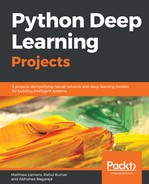Book Description
Insightful practical projects to master deep learning and neural network architectures using Python, Keras and MXNet
About This Book
- Rich projects on computer vision, NLP, and image processing
- Build your own neural network and explore innumerable possibilities with deep learning
- Explore the power of Python for deep learning in various scenarios using insightful projects
Who This Book Is For
This book is for developers, data scientists, or enthusiasts, who have sound knowledge of python programming, basics of machine learning, and want to break into deep learning, either for opening a new career opportunity or for realizing their own AI projects.
What You Will Learn
- Set up a Deep Learning development environment on AWS, using GPU-powered instances and the Deep Learning AMI
- Implement Sequence to Sequence Networks for modeling natural language processing
- Develop an end-to-end speech recognition system
- Build a system for pixel-wise semantic labeling of an image
- Develop a system that generates images and their regions
In Detail
Deep Learning has quietly revolutionized every field of Artificial Intelligence, enabling the development of applications that a few years ago were considered almost impossible.
This book will provide all the knowledge needed to implement complex deep learning projects in the field of computational linguistics and computer vision. Each new project will build upon the experience and knowledge accumulated in the previous ones, allowing the reader to progressively master the subject.
You will learn neural network models implementing a text classifier system using Recurrent Neural network model (RNN) and optimize it to understand the shortcomings you might come across while implementing a simple deep learning system. If you are looking to implement intelligent systems like Automatic Machine Translation, Handwriting Generation, Character Text Generation, Object Classification in Photographs, Colorization of Images, Image Caption Generation, Character Text Generation or Automatic Game Playing into your application then this book is for you.
By the end of this book, you will come across various Recurrent and Convolutional Neural network implementations with practical hands-on to modeling concepts like regularization, Gradient clipping, and gradient normalization, LSTM, Bidirectional RNN’s through a series engaging projects.
Style and approach
One stop guide to gain deep learning knowledge and skills by working on authentic, engaging and complex projects with detailed end-to-end implementations.
Downloading the example code for this book. You can download the example code files for all Packt books you have purchased from your account at http://www.PacktPub.com. If you purchased this book elsewhere, you can visit http://www.PacktPub.com/support and register to have the code file.
